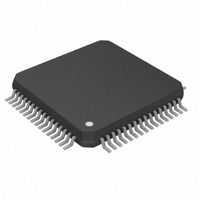DS3106LN+ Maxim Integrated Products, DS3106LN+ Datasheet - Page 44

DS3106LN+
Manufacturer Part Number
DS3106LN+
Description
IC TIMING LINE CARD 64-LQFP
Manufacturer
Maxim Integrated Products
Type
Timing Card ICr
Datasheet
1.DS3106LN.pdf
(87 pages)
Specifications of DS3106LN+
Input
CMOS, LVDS, LVPECL, TTL
Output
CMOS, LVDS, LVPECL, TTL
Frequency - Max
312.5MHz
Voltage - Supply
1.62 V ~ 1.98 V
Operating Temperature
-40°C ~ 85°C
Mounting Type
Surface Mount
Package / Case
64-LQFP
Frequency-max
312.5MHz
Lead Free Status / RoHS Status
Lead free / RoHS Compliant
Register Name:
Register Description:
Register Address:
Bit #
Name
Default
Note: The FREQ1, FREQ2, and FREQ3 registers must be read consecutively. See Section 8.3.
Bits 7 to 0: Current DPLL Frequency (FREQ[7:0]). The full 19-bit FREQ[18:0] field spans this register, FREQ2,
and FREQ3. FREQ is a two’s-complement signed integer that expresses the current frequency as an offset with
respect to the master clock frequency (see Section 7.3). Because the value in this register field is derived from the
DPLL integral path, it can be considered an average frequency with a rate of change inversely proportional to the
DPLL bandwidth. If LIMINT = 1 in the
minimum or maximum frequency. The frequency offset in ppm is equal to FREQ[18:0] 0.0003068. See Section
7.7.1.6.
Application Note: Frequency measurements are relative, i.e., they measure the frequency of the selected reference
with respect to the local oscillator. As such, when a frequency difference exists, it is difficult to distinguish whether
the selected reference is off frequency or the local oscillator is off frequency. In systems with timing card
redundancy, the use of two timing cards, master and slave, can address this difficulty. Both master and slave have
separate local oscillators, and each measures the selected reference. These two measurements provide the
necessary information to distinguish which reference is off frequency, if we make the simple assumption that at
most one reference has a significant frequency deviation at any given time (i.e., a single point of failure). If both
master and slave indicate a significant frequency offset, then the selected reference must be off frequency. If the
master indicates a frequency offset but the slave does not, then the master’s local oscillator must be off frequency.
Likewise, if the slave indicates a frequency offset but the master does not, the slave’s local oscillator must be off
frequency.
Register Name:
Register Description:
Register Address:
Bit #
Name
Default
Bits 7 to 0: Current DPLL Frequency (FREQ[15:8]). See the FREQ1 register description.
19-4629; Rev 4; 8/10
____________________________________________________________________________________________ DS3106
7
0
7
0
6
0
6
0
FREQ1
Frequency Register 1
0Ch
FREQ2
Frequency Register 2
0Dh
MCR9
5
0
5
0
register, the value of FREQ freezes when the DPLL reaches its
4
0
4
0
FREQ[15:8]
FREQ[7:0]
3
0
3
0
2
0
2
0
1
0
1
0
44 of 87
0
0
0
0












